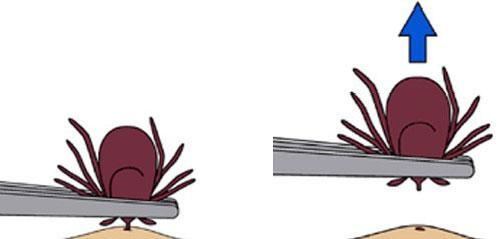From the CDC:
If you find a tick attached to your skin, there's no need to panic. There are several tick removal devices on the market, but a plain set of fine-tipped tweezers will remove a tick quite effectively.
How to remove a tick
- Use fine-tipped tweezers to grasp the tick as close to the skin's surface as possible. Do NOT use your fingers!
- Pull upward with steady, even pressure. Don't twist or jerk the tick; this can cause the mouth-parts to break off and remain in the skin. If this happens, remove the mouth-parts with tweezers. If you are unable to remove the mouth easily with clean tweezers, leave it alone and let the skin heal.
- After removing the tick, thoroughly clean the bite area and your hands with rubbing alcohol, an iodine scrub, or soap and water.
- Dispose of a live tick by submersing it in alcohol, placing it in a sealed bag/container, wrapping it tightly in tape, or flushing it down the toilet. Never crush a tick with your fingers.

Follow-up
If you develop a rash, fever or severe headache within a month of removing a tick, see your doctor. Be sure to tell the doctor about your recent tick bite, when the bite occurred, and where you most likely acquired the tick.
And
Treating Tick Bites
Reassurance
- Most tick bites are harmless.
- The spread of disease by ticks is rare.
- If the tick is still attached to the skin, it will need to be removed.
- Covering the tick with petroleum jelly, nail polish, or rubbing alcohol doesn't work. Neither does touching the tick with a hot or cold object.
- The best prevention of tick diseases is removal of the attached tick within 24-36 hrs.
- Try one of the following techniques:
Wood Tick Removal: Try Soapy Cotton Ball First
- Apply liquid soap to a cotton ball until it's soaked.
- Cover the tick with the soap-soaked cotton ball.
- Let it stay on the tick for 30 seconds.
- The tick will usually be stuck to the cotton ball when you lift it away.
Wood Tick Removal: Try Tweezers Second
- Use tweezers and grasp the tick close to the skin (on its head).
- Pull the wood tick straight upward without twisting or crushing it.
- Maintain a steady pressure until it releases its grip.
- If tweezers aren't available, use fingers, a loop of thread around the jaws, or a needle between the jaws for traction.
Deer Tick Removal
- Tiny deer ticks need to be scraped off with a fingernail or credit card edge.
Tick's Head
- If the wood tick's head breaks off in the skin, remove it.
- Clean the skin with rubbing alcohol.
- Use a sterile needle to uncover the head and lift it out.
- If a small piece of the head remains, the skin will eventually shed it.
- If most of the head is left, call your doctor.
Antibiotic Ointment
- Wash the wound and your hands with soap and water after removal to prevent catching any tick disease.
- Apply antibiotic ointment such as Polysporin to the bite once (no prescription needed).
Expected Course
- Tick bites normally don't itch or hurt. That's why they often go unnoticed.
Call Your Doctor If
- You can't remove the tick or the tick's head.
- Fever, rash and/or severe headache in the next 2-4 weeks.
- Bite begins to look infected.
- Your child becomes worse.
Preventing Tick Bites
Prevention
- When hiking in tick-infested areas, wear long clothing and tuck the ends of pants into socks. Apply an insect repellent to shoes and socks.
- Permethrin products applied to clothing are more effective than DEET products against ticks.
Tick Repellent for Skin: DEET [Dr. T likes Sawyer Family DEET Product]
- DEET is an effective tick repellent.
- Use 30% DEET for children and adolescents (American Academy of Pediatrics recommendation, 2003) (30% DEET protects for 6 hours).
Tick Repellent for Clothing: Permethrin [Dr. T likes the Sawyer Family Permethrin Product]
- Permethrin-containing products (eg, Duranon, Permanone) are highly effective tick repellents.
- An advantage over using DEET is that they are applied to and left on clothing instead of skin. Apply it to clothes, especially pants, cuffs, socks, and shoes. You can also put it on other outdoor items (eg, mosquito screen, sleeping bags).
- Do not apply permethrin to skin (Reason: it's rapidly degraded on contact with skin).

 Avoid folklore remedies such as "painting" the tick with nail polish or petroleum jelly, or using heat to make the tick detach from the skin. Your goal is to remove the tick as quickly as possible–not waiting for it to detach.
Avoid folklore remedies such as "painting" the tick with nail polish or petroleum jelly, or using heat to make the tick detach from the skin. Your goal is to remove the tick as quickly as possible–not waiting for it to detach.